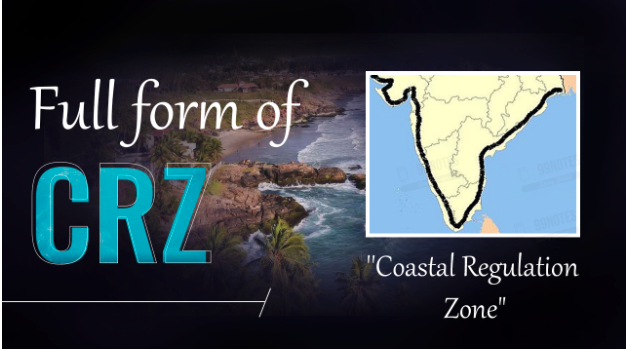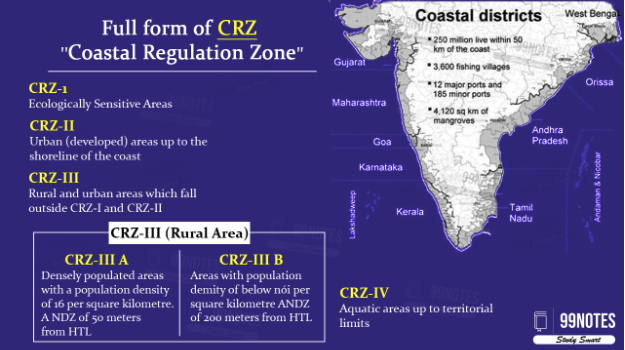CRZ Full Form, Rules, Zones and Notification, CRZ UPSC
CRZ Full Form
CRZ full form representing “Coastal Regulation Zone”. It deals with proper management and regulation of the coastal zones of our country. India has more than 7000 kilometers of coastline, ranking 20th in the world among the countries with the longest coastline.

The government of India established the Coastal Regulation Zone (CRZ) in 1991 with the goal of safeguarding coastal ecology and conserving the coastal environment
What is CRZ?
The region close to the coast known as the Coastal Regulation Zone (CRZ) consists of the shoreline up to 500 meters from the High Tide Line (HTL) plus a 100 meter stretch along the banks of streams, estuaries, backwaters, and rivers that are subject to tidal change.
These CRZ regulations apply to these zones.
In order to protect the fragile ecosystem next to the sea, the Coastal Regulation Zone (CRZ) regulations control and regulate commercial, human, and Industrial activities that are in close proximity to the shoreline. The Ministry of Environment, Forest and Climate Change (MoEFCC) released the Coastal Regulation Zone (CRZ) notification for the first time in 1991 in compliance with section 3 of the Environment Protection Act of 1986.
Classification of Coastal Regulation Zones.
The Coastal Regulation Zone Notification from 1991 to 2003 grouped the nation’s coastal regions into four categories. The following table enumerates and describes them:
| Coastal Regulation Zone 1 | Regions that are crucial to preserving the coastal ecosystem and are ecologically delicate
Authorizations :
|
| Coastal Regulation zone 2 | Places that have been developed all the way to the seaside.
Authorizations:
|
| Coastal
Regulation Zone 3 |
CRZ-3 covers Urban and Rural Areas not covered by CRZ -1 and CRZ- 2.These are municipally owned lands that are not developed.
Authorizations:
|
| Coastal Regulation
Zone 4 |
Andaman and Nicobar island coastal regions, lakshadweep and small islands aside from those classified as CRZ-I, CRZ-ll, CRZ-lll.This area us ehere solid waste should be disposed of.
Authorizations:
|
Coastal Regulation Zone Notifications
The Ministry of Environment, Forest and Climate Change notified the Coastal Regulation Zone Notification in 1991 with the intention of conserving and protecting the coastal environment. The notification was later amended in 2011. On the basis of the comments received, the notification has been changed on occasions.
Shailesh Nayak Committee Report on CRZ
The Ministry of Environment, Forests and Climate Change (MoEFCC) received the report from the six member committee in January 2015 after it was established in June 2014. According to the report, as mandated by numerous states, it suggests decentralizing powers to local authorities as well as state and union territory governments.
In order to loosen the current limits to expansion in coastal areas, the Shailesh Nayak Committee report has planned to permit housing infrastructure and slum reconstruction operations, tourist, ports and harbour , and fisheries related action coastal management zones.
The coastal states and union territories made recommendations based on the Shailesh Nayak Committee’s recommendations, and the Coastal Regulation Zone 2018 was released as a result.
Coastal Regulation Zone Notification 2011
The 2011 Coastal Regulation Zone Notification took into account the concerns raised by the 1991 notification and suggested changes in light of those findings. The 2011 Coastal Regulation Zone Notification has undergone the following reforms:
CRZ-1
Exemption for the recently constructed areas.
- Construction of roads and trans harbour sea kinks that are situated between HTL and LTL, etc, and don’t impact the tidal flow
- Projects related to the Department of Atomic Energy.
- Other permissions granted for activities between HTL and LTL are: Natural Gas Extraction & Exploration salt production facilities, Desalination plants, storage facilities (non hazardous cargo) within notified ports.
CRZ-2
Authorizations for building construction on the landward part of the hazardous line.
Other permission provided for tasks involving HTL and LTL include:
- Desalination plans, etc.
- Only certain construction is allowed in accordance with the notification’s rule.
CRZ-3
New construction exceptions.
- construction of roads and trans – harbour sea links that don’t affect the tidal flow, are between HTL & LTL,etc.
- Undertakings including the production of salt, petroleum products, the department of atomic energy, and other public facilities.
- Construction of houses for local communities in some areas.
CRZ-4
There are no limitations on the customary fishing practices carried out by nearby populations.
It is forbidden to release or deposit solid trash or untreated sewage in these regions.
Changes made by 2018-2019 Coastal Regulation Zone notifications.
A committee headed by Dr. Shailesh Nayak was established by the Ministry of Environment, Forest and Climate Change in June 2014 to investigate the concerns and issues raised by Coastal States/UTs and other relevant parties in order to recommend suitable modifications to the CRZ notification, 2011.
In 2015, the Shailesh Nayak Committee presented its recommendations after extensive consultation with State Governments and other relevant parties.
The draft notification received clearance in December 2018 from the Union Cabinet.
Then, in January 2019, the MoEFCC announced revised CRZ regulations 2019
In accordance with section 3 of the Environment Protection Act 1986, the updated CRZ notification aims to:
- To encourage sustainable development grounded in scientific principles, including the risk associated with natural disasters, sea level rise brought on by global warming.
- To conserve and protect the unique environment of coastal stretches and marine areas, in addition to providing the local communities in the coastal area with a secure means of subsistence as fishermen.
The following are the new changes made to the Coastal Regulation Zone Notification in 2018 and 2019:
- Development Projects
- No development zone (NDZ) reduced
- For CRZ-lll (Rural) areas, two separate categories have now been stipulated as below
| CRZ-III A | Heavily inhabited rural areas with a 2161/kms2 population density.
Their NDZ will be 50 meters from HTL According to the 2011 CRZ notification, it was formerly 200 meters from HTL |
| CRZ-III B | Heavily inhabited rural areas with a 2161/km2 population density.
Their NDZ will be 200 meters from HTL. |
- Tourism Projects/Infrastructure.
- FSI Norms Eased.
- The Floor Space Index or the Floor Area Ratio (FAR) for CRZ -ll (Urban) regions had been frozen in accordance with the 1991 Development Control Regulation (DCR) levels, according to the CRZ, 2011 Notification.
- Defreezing the same and allowing FSI for construction projects as of the new notification date have been decided upon in the CRZ, 2019 Notification.
- Pollution Abatement.
- Critically Vulnerable Coastal Areas (CVCA):
- The west bengal sundarban region and other ecologically sensitive areas designated under the 1986 Environment (Protection) Act.
- Coastal communities, particularly fishermen who rely on coastal resources for a sustainable living are involved in their management
FAQ’s related to CRZ full form
Coastal Regulation Zone Clearance to the projects are being regulated under the specified provisions of CRZ notification, 2011 which inter alia stipulate the appraisal process and the approval of the projects with laid down safeguards for environmental management.
CRZ-3 rules state only agriculture related activities and limited public faciliare permitted in this zone.
The CRZ 2011 notification made the drainage of sewage and waste in all the zones illegal and declared a date by which defaulters had to phase these activites out. Industries that did not phase out by the declared date would be considered as violators.
CRZ full form is Coastal Regulation Zone. It deals with proper management and regulation of the coastal zones of our Country India.
Other Related Links:
| Full Form | UNESCO Full form |
| SAARC full form | ASEAN Full form |
| IMF Full Form | BRICS Full Form |
| COP Full Form | UPSC Notes |
